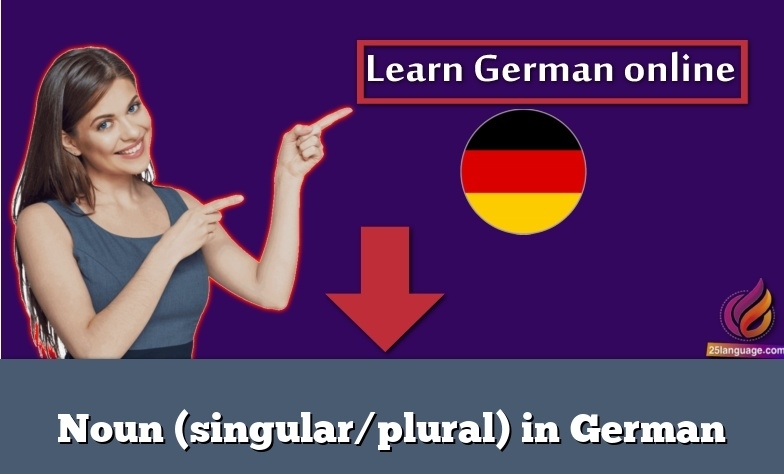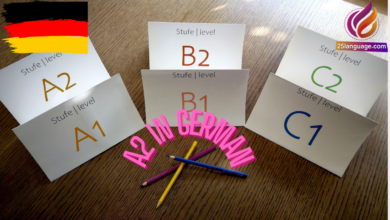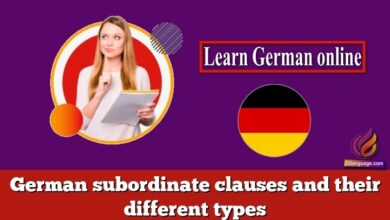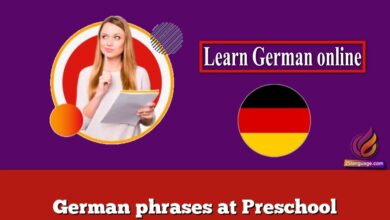Noun (singular/plural) in German

Noun (singular/plural) in German.Here’s a table showing examples of nouns in both singular and plural forms in German, along with their English translations. German nouns can have a variety of plural forms, which don’t always follow a single rule as they do in English.
| German Noun (Singular) | German Noun (Plural) | English Noun (Singular) | English Noun (Plural) |
|---|---|---|---|
| das Buch | die Bücher | the book | the books |
| der Apfel | die Äpfel | the apple | the apples |
| die Katze | die Katzen | the cat | the cats |
| der Baum | die Bäume | the tree | the trees |
| das Haus | die Häuser | the house | the houses |
| die Blume | die Blumen | the flower | the flowers |
| der Stuhl | die Stühle | the chair | the chairs |
| das Kind | die Kinder | the child | the children |
In these examples, you can see how the article of the noun (der, die, das) changes to “die” in the plural for all genders. Also, the plural forms of nouns in German can vary greatly and are one of the more complex aspects of German grammar.
Examples
Sure, I can provide a table with examples of basic sentence structures in German, along with their English translations. This will help illustrate how typical German sentences are formed and how they correspond to English.
| German Grammar Concept | German Example | English Translation |
|---|---|---|
| Simple declarative | Ich lese ein Buch. | I am reading a book. |
| Simple interrogative | Liest du das Buch? | Are you reading the book? |
| Negative sentence | Ich habe kein Geld. | I have no money. |
| Command | Öffne das Fenster! | Open the window! |
| Compound sentence | Ich kaufe Brot, und sie isst Käse. | I buy bread, and she eats cheese. |
| Sentence with modal verb | Ich kann heute nicht kommen. | I cannot come today. |
| Sentence with a subordinate clause | Ich denke, dass er schläft. | I think that he is sleeping. |
These examples cover a range of basic sentence structures in German, from simple statements and questions to more complex sentences involving compound elements and subordinate clauses. German sentence structure can be quite flexible, especially in more complex sentences, but these examples provide a good foundation for understanding the basics.
Sentences
Certainly! Below is a table featuring examples of basic sentence structures in German, accompanied by their English translations. This table should help illustrate the fundamental aspects of constructing sentences in German.
| German Sentence Structure | German Example | English Translation |
|---|---|---|
| Simple Statement | Der Hund schläft. | The dog is sleeping. |
| Yes/No Question | Schläft der Hund? | Is the dog sleeping? |
| Simple Negative | Ich habe kein Auto. | I don’t have a car. |
| Command | Steh auf! | Stand up! |
| Compound Sentence | Ich lese und sie schreibt. | I am reading and she is writing. |
| Question with ‘W’ (Interrogative) | Was liest du? | What are you reading? |
| Subordinate Clause | Ich weiß, dass er schläft. | I know that he is sleeping. |
These sentences cover a range of basic structures, including statements, questions, commands, and compound sentences, giving a good foundation for understanding simple German syntax.
Phrases
Sure, here’s a table with examples of basic sentence structures in German, along with their English translations. This table will help in understanding how basic phrases are constructed in German.
| German Sentence Structure | German Example | English Translation |
|---|---|---|
| Subject-Verb-Object | Der Junge spielt Fußball. | The boy plays soccer. |
| Verb-Subject | Hat Maria das Buch gelesen? | Has Maria read the book? |
| Subject-Verb-Adverb | Das Auto fährt schnell. | The car drives fast. |
| Subject-Verb-Adjective | Der Himmel ist blau. | The sky is blue. |
| Compound Sentence | Ich kaufe ein Brot und er isst Käse. | I buy bread and he eats cheese. |
| Verb-Subject-Object | Liest du das Buch? | Are you reading the book? |
| Subject-Verb-Negation | Sie hat kein Geld. | She has no money. |
These examples cover a variety of basic structures, including declarative sentences, questions, and compound sentences. They provide a straightforward way to grasp the fundamentals of German sentence construction.
Comprison
To illustrate the comparison between basic sentence structure and question structure in German, along with their English translations, here is a table:
| Sentence Type | German Structure | German Example | English Translation |
|---|---|---|---|
| Basic Sentence Structure | Subject-Verb-Object (SVO) | Der Hund jagt die Katze. | The dog chases the cat. |
| Question Structure | Verb-Subject-Object (VSO) for Yes/No Questions | Jagt der Hund die Katze? | Does the dog chase the cat? |
| ‘W’ Question Word + Verb-Subject-Object for Information Questions | Was macht der Hund? | What is the dog doing? |
- Basic Sentence Structure: German typically follows the Subject-Verb-Object order for simple declarative sentences, similar to English.
- Question Structure: For yes/no questions, the verb moves to the beginning (Verb-Subject-Object). For questions asking for information, a ‘W’ question word (like “was” for “what”, “wo” for “where”) is placed at the beginning, followed by the verb and subject.
This comparison shows how German rearranges the basic sentence structure to form questions, a common feature in many languages.





























